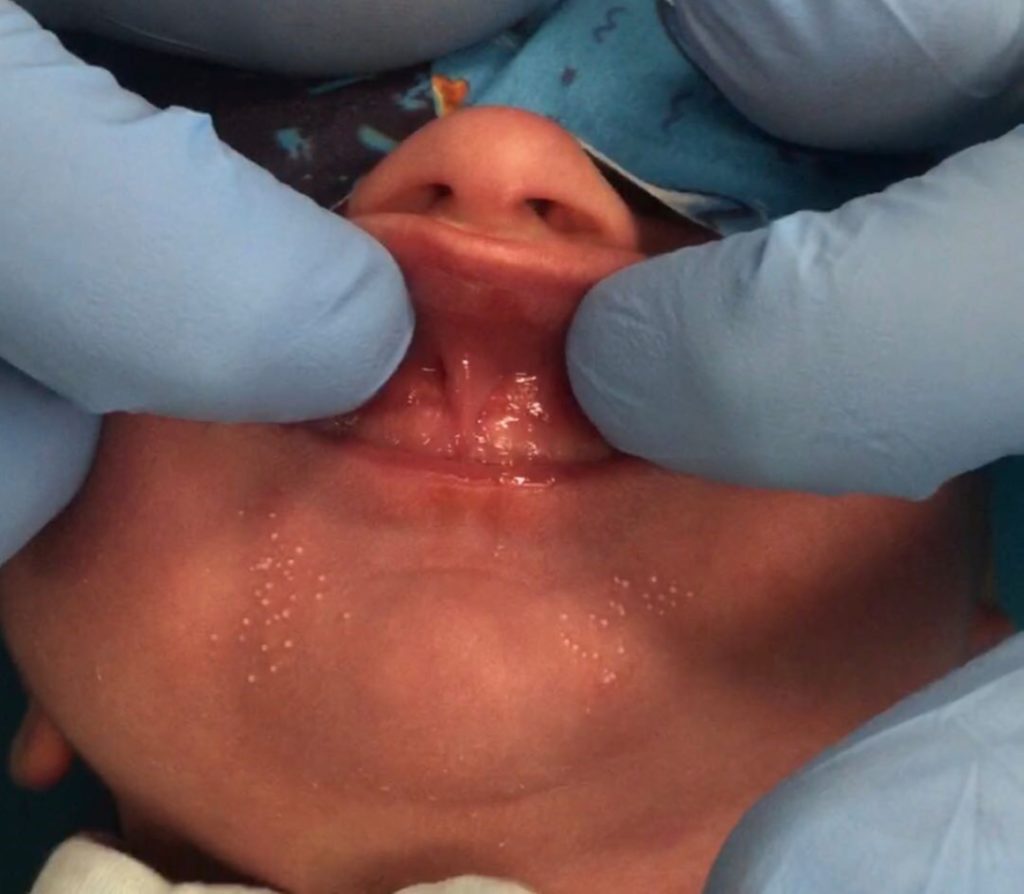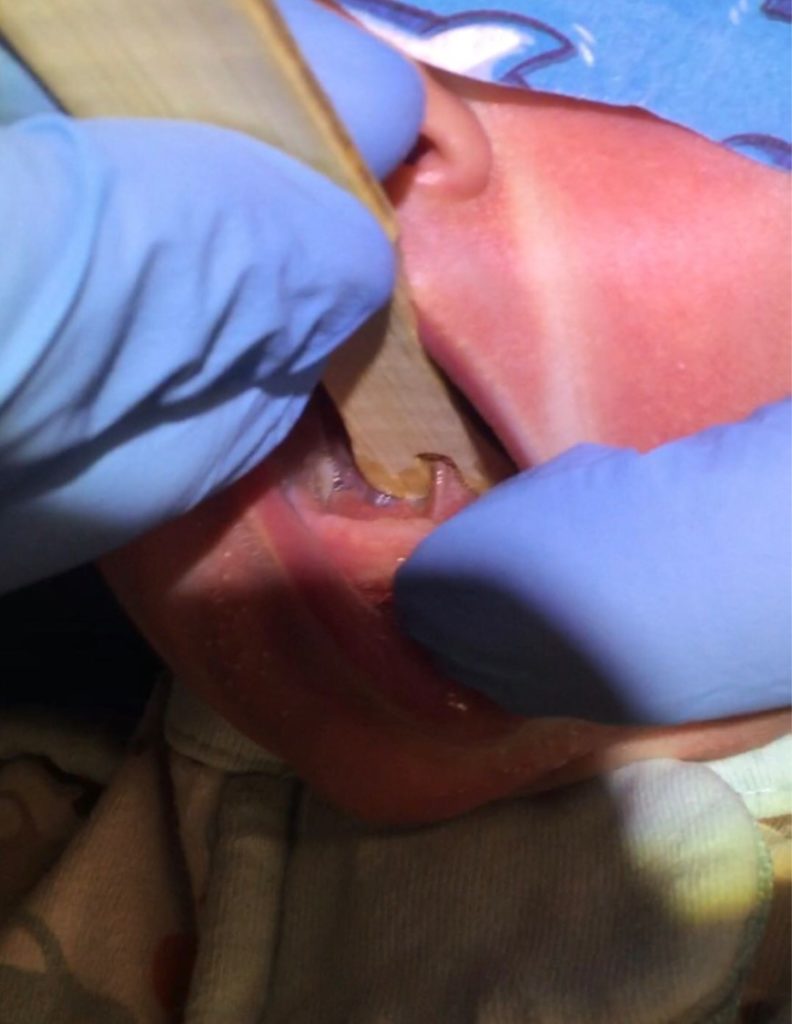Tongue and Lip Ties
What is a Frenectomy?
A frenectomy is a procedure used to correct a congenital condition in which the lingual (tongue) or labial (lip) frenum is too tight, causing restrictions in movement that can cause significant difficulty with breastfeeding, and in some instances, other health problems like dental decay or spacing, speech difficulties and digestive issues. When it affects the lingual frenulum, this condition is commonly called a tongue tie (the medical term is ankyloglossia). Approximately 5% of the population has this condition, so your lactation consultant or doctor may feel that a procedure is warranted to improve symptoms.
Infant Frenectomy information
What to expect
Dr. Sanders will evaluate your child, taking into account your report of how breastfeeding is going and the mother’s symptoms. If she believes that your child could benefit from a tongue or lip tie release you will have the option of having it performed that day.
If you elect to have the procedure done at this time, a small amount of topical anesthetic will be applied to the area(s) to be treated. This medication works very quickly.
The procedure is very quick, the actual time of lasering being generally under 1 minute.
Crying and fussing are common during and after the procedure.
You may breastfeed, bottle-feed or soothe your babe in any manner you would like following the procedure.
There will be some reattachment after the procedure as the frenum will re-establish itself. We want to make sure that the frenum stays towards the back of the tongue and is still flexible. The best results with the least re-attachment occur when good function is achieved. How well your baby is able to nurse and move their tongue will dictate how it heals more than anything. Because of that we very strongly recommend working with a lactation consultant and a body worker as outlined below as well as performing the stretches as outlined.
Stretches
I feel that post-procedure stretches are key to getting optimal result. These stretches are NOT meant to be forceful or prolonged. It’s best to be quick and precise with your movements.
The main risk of a frenectomy is that the mouth heals so quickly that it may prematurely reattach at either the tongue site or the lip site, causing a new limitation in mobility and the persistence or return of symptoms. The exercises are best done with the baby placed on a solid surface (change table, bed, floor – not your lap) with you standing at their head.
A small amount of spotting or bleeding is common during the stretches, especially in the first few days. Because a laser is being used, bleeding is minimized. Wash your hands well prior to doing stretches (gloves aren’t necessary).
The released area will form a wet scab after the first day. Because it is wet, it will appear white and soft. This is nature’s “bandaid”. This is what you will be pressing against. The healing will be happening under the scab, just like a scrape anywhere else on your body. The white area will get smaller each day, but the HEALING IS STILL HAPPENING! So even though the white scab will heal you MUST continue the stretching or the new frenum will not be as long as possible and the surgery will need to be repeated.
The Upper Lip – is the easier of the 2 sites to stretch. If you have both sites to stretch I recommend starting with the lip. Typically, babies don’t like either stretches and may cry, so starting with the lip allows you to get under the tongue easier once the baby starts to cry. For the upper lip, simply place your finger under the lip and move it up as high as it will go (until it bumps into resistance). Then gently sweep from side to side for 1-2 seconds. Remember, the main goal of the procedure is the insert your finger between the raw, opposing surfaces of the lip and the gum so they can’t stick together.
The Tongue – should be your next area to stretch. Insert both index fingers into the mouth (insert in the mouth and go towards the cheek to stretch out the mouth, making room for your other index finger.) Then use both index fingers to dive under the tongue and pick it up, towards the roof of the baby’s mouth. The tongue needs two separate stretching motions:
- Once you are under the tongue, try to pick the tongue up as high as it will go (towards the roof of the baby’s mouth). Hold it there for 1-2 seconds and then relax. The goal is to completely unfold the diamond so that it’s almost flat in orientation (remember, the fold of the diamond across the middle is the first place it will reattach). The key to the success of this stretch is that your fingers are placed deep enough prior to lifting the tongue up. I recommend placing your finger on either side of the diamond and pushing into the sides of the diamond before lifting up on the tongue. To make the stretch effective, make sure the tongue goes up and not backwards.
- With one finger propping up the tongue, place your other finger in the middle of the diamond and turn your finger sideways and use a lifting motion from front to back to try to keep the diamond as deep as possible. Use a lifting motion where you sweep through the diamond, trying to separate the horizontal fold across that diamond. Make sure your finger starts within the diamond when doing this stretch.
Repeat the stretches every 4 hours for the first two weeks (going no more than 6 hours between stretches). For the third week perform stretches every 6 hours.
Sucking exercises
It is important to remember that you need to show your child that not everything you are going to do to the mouth is associated with pain. Additionally, babies can have disorganized or weak sucking patterns that can benefit from exercises. The following exercises are simple and can be done to improve suck quality.
- Slowly rub the lower gum line from side to side and your baby’s tongue will follow your finger. This will help strengthen the lateral movements of the tongue.
- Let your child suck on your finger and do a tug-of-war, slowly trying to pull your finger out while they try to suck it back in. This strengthens the tongue itself.
- Let your child suck your finger and apply gentle pressure to the palate, and then roll your finger over and gently press down on the tongue and stroke the middle of the tongue.
After the procedure
- Expect at least 48-72 hours of discomfort and fussiness. This is due to using new muscles and soreness at the wound sites. Some swelling in area is also normal, this is most often seen in the lip after release of thicker lip ties.
- I recommend lots of nursing and skin to skin time to soothe your baby. For many this is enough to help them manage discomfort.
- If discomfort is not managed by skin to skin and nursing comfort, give pain medication as directed by pediatrician.
- A natural alternatives is Arnica, as listed below:
- Arnica tablets: Arnica 200C (or 30C if you can’t find the 200); 10-15 pellets in a dropper bottle. Fill with distilled water and dissolve/shake. Every 60-90 minutes, 10 drops of that liquid orally. If fussier, can do every 30 min.
It is essential that you follow-up with your lactation consultant after the procedure to ensure optimal results. Additional resources for bodywork and suck training are available if necessary.
Call our office for any of the following:
- Uncontrolled bleeding
- Refusal to nurse or take a bottle
- Fever > 101.5
Other Help:
I strongly encourage all babies see a lactation consultant or speech therapist who is knowledgeable about tongue ties sometime the week after the release and for continued support as needed.
Most babies benefit from body work to release the surrounding tightness, this leads to a more successful release. The ties under the tongue are related to the entire area under the neck and baby may need help getting rid of that tightness for optimal healing and results. Here are a few providers in the Missoula area that I have worked with and discussed tongue ties with. Please be sure to see a provider (chiropractor, cranial sacral therapies, osteopath, etc.) who is very knowledgeable about infant care.
Dr. Liz Walker – Primal Practice Chiropractic 406-549-8969
Dr. Matt Anderson – FNP – Anderson Integrative Medicine 406-493-0712
Dr. Torrie Cheff – Missoula Family Chiropractic 406-721-5360
Dr. Linda Matz – Bloom Chiropractic 406-203-5180
Becca O’Brien – Cranial Sacral Therapy 458-206-0757
James Fix (Cranial Sacral Therapy) – Your Energy Fix – 406-210-9805
Resources
Adult and children Frenectomy information
For adults and older children who have been functioning for some time with their tongue tie it is very important for best results to re-train the tongue on how to function. This is best done by working with a myofunctional therapist. We will discuss this further as well as start on some exercises in office.


